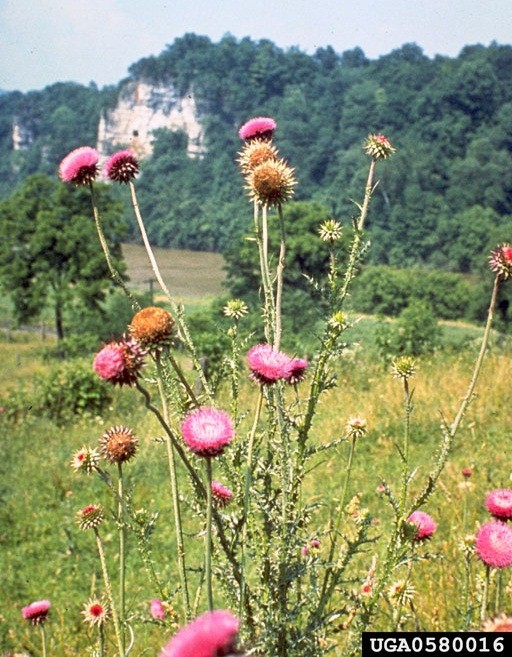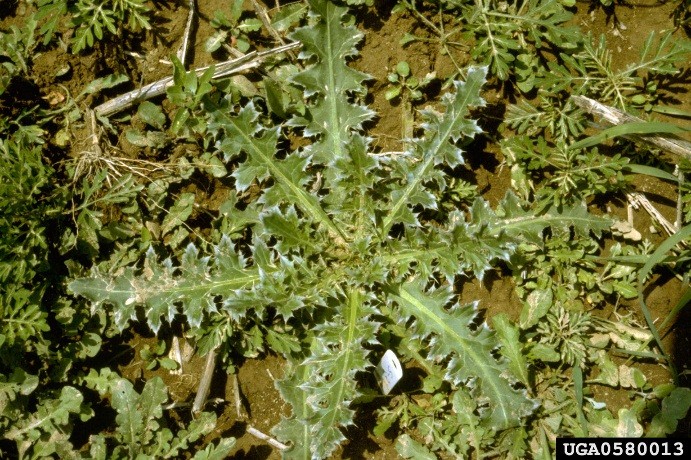Carduus nutans
Musk Thistle / Nodding Thistle
Synonyms: Carduus thoermeri
Order: Asterales
Family: Asteraceae


Photographer: Loke T. Kok, Virginia polytechnic Institute and State University
Source: Bugwood.org
Description
Musk thistles (Carduus nutans) are biennial thistles. Populations in North America exhibit almost continuous variation in characteristics such as hairiness, leaf size, spine length, flower stalk diameter, width and shape of bracts, and corolla length. In general, Musk thistles have large (1.5-3.5 in), showy pink-purple flowers on long (1.5-6 ft), multi-branched and spiny stems. The dark green leaves are coarsely bipinnately lobed, with a smooth waxy surface, and a white to yellowish sharp spine at the tip. Seeds are yellowish-brown or straw-colored with plumose bristles. Flower heads will bow to a 90o angle from the stem when mature, which is how it received its other common name, nodding thistle.
Ecological Threat: Carduus nutans is a highly competitive plant and that can replace much of the native vegetation in pastures and disturbed areas. Because musk thistle is unpalatable to wildlife and livestock, selective grazing leads to severe decline of native meadows and grasslands as grazing animals focus their foraging on other plants. While other plants are being grazed, musk thistle is able to grow and prosper, giving it a competitive advantage and making it a major pest for grazing operations.
Biology: Musk thistle is usually a biennial, requiring 2 years to complete a reproductive cycle. However, in warmer climates it might complete a full cycle (germination to flowering) in a single year. Seedlings emerge in mid to late July and develop into a rosette (pictured right) where plants can reach 4 feet wide and they overwinter as a rosette until they begin to stem/bolt in mid-March. Flowers emerge in early May to August. Seed dispersal occurs about one month after the flowers form. The number of seedheads per plant depends on site condition, and ranges from about 24 to 56 on favorable sites and 1 to 18 on less favorable sites. What makes Carduus nustans a difficult plant to control is that, a single flower head may produce 1,200 seeds and a single plant up to 120,000 seeds, which may be windblown for miles and can remain viable in the soil for over ten years.
History: First appeared in the United States in 1852. It was introduced accidentally from seed mixes. However, it was not discovered until 1942 in Davidson County, Tennessee. It is declared a noxious weed in many of the United States it is present in.
Click here for Citizen Scientist sightings in Texas
U.S. Habitat: Carduus nutans prefers moist alluvial soils in open, natural areas but will grow in eroded uplands without difficulty. Not likely to be found in deserts, dense forests, high mountains, coastal areas, or newly cultivated fields.
Distribution
Native Origin: Eurasia and Northern Africa
U.S. Present: All states except: AK, FL and HI
Resembles/Alternatives
Musk thistle is similar to Canada thistle (Cirsium arvense) and bull thistle (Cirsium vulgare) and the plumeless thistle (Carduus acanthoides), all three of which are invasive. There is some evidence of hybridization occurring between musk thistle and the plumeless thistle, when the two species overlap in distribution. Ribosomal genomes and molecular data suggest even though these are two separate species, there has not been a significant divergence in either the chloroplast genome of transcribed nuclear ribosomal genomes allowing them to inter-breed. The hybridization allows for genetic variance and can lead to stronger lineages that may be harder to manage.
Musk thistle can be distinguished from other thistles by the large disk-shaped flowers and spine-tipped leaves. Unlike musk thistle, the Canada thistle, has small flower heads and smooth stems and plumose bristles; while the Bull thistle has upper leaf surfaces covered with stiff bristly hairs that feel rough.
Management
Fortunately, cutting or removing thistles can be effective in reducing thistle populations. Annual and biennial thistles, if mowed within two days of flowering of the terminal blooms, will not produce seed or regenerate significantly. Timing in mowing is important; if mowing occurs four days after terminal bloom anthesis (full flowering), significant amounts of seed are produced. Please be sure to dispose of seeds, shoot and roots in a sealed garbage bag in the trash. Also, dispose of the seedhead carefully to avoid wind dispersal.
There are three biological control insects that have been established for management for musk thistle populations. Rhinocyllus conicus, a European weevil that feeds on developing seed heads has been introduced into the United States and Canada, particularly for control of the musk thistle. It has one generation per year. The larvae feed on the seeds and destroy them. Another weevil Trichosirocalus horridus is also a weevil of European origin that can infect several genera in the thistle tribe (Carduus, Cirsium, Onopordum and Silybum); and is a very effective control agent against Canduus nutans. Cheilosia corydon is a fly produces one generation per year. Its larvae damage the leaves, stems, and crown of musk thistle, Italian thistle, and plumeless thistle. This fly lowers seed production and can kill the plant when it infests roots. Even though these weevils have proven very successful certain entities like the National Park Service are not able release it on their lands, due to potential impacts on native plants. Also, Cheilosia corydon has been observed in several native thistle species, so caution should be used when considering it as a biological control agent.
Spot treatments, rather than broadcast treatments, are preferred. Chemical control for annuals, biennials, and perennials must be initiated before the plants blossom and produce seeds. Young plants are most susceptible to herbicides. Chlorsulfuron is very effective in the early bloom stage; therefore best results are obtained during the spring when plants are in their initial and heaviest growth stage. However, plants can develop a resistance is the same herbicide is continually used as a long-term control method.
In most cases, combining a chemical and biological control is a more viable approach to thistle management.
References
McCarty, M.K., and J.L. Hatting. 1975. Effects of herbicides or mowing on musk thistle seed production. Weed Res. 15:363-367.
Woodward, Susan L., and Joyce Ann. Quinn. 2011. Musk Thistle. Encyclopedia of Invasive Species: From Africanized Honey Bees to Zebra Mussels. Santa Barbara, CA: Greenwood. 399-403. Print.
Zouhar, Kris. 2002. Carduus nutans. In: Fire Effects Information System, [Online]. U.S. Department of Agriculture, Forest Service, Rocky Mountain Research Station, Fire Sciences Laboratory (Producer).
Internet Sources
http://www.invasivespeciesinfo.gov/plants/muskthistle.shtml
http://www.nature.nps.gov/biology/ipm/manual/thistle.cfm
http://www.fs.fed.us/database/feis/plants/forb/carnut/all.html
http://www.se-eppc.org/manual/muskthistle.html
http://www.oregon.gov/ODA/PLANT/WEEDS/pages/bio_profile_chco.aspx
http://www.texasinvasives.org/plant_database/detail.php?symbol=CANU4
http://bugguide.net/node/view/92634/bgimage
http://bugguide.net/node/view/87921
http://www.forestryimages.org/browse/detail.cfm?imgnum=0025038
 Texas Invasive Species Institute
Texas Invasive Species Institute